Range Rover Evoque: Maintenance Schedules - Diesel Engines
Under Bonnet View
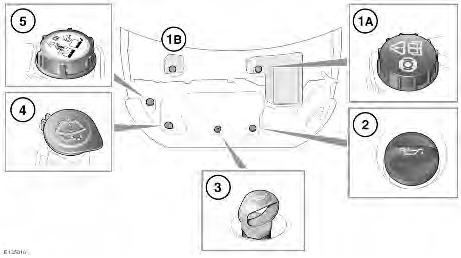
- 1A - Brake/clutch fluid reservoir caps (beneath cover) left-hand drive (LHD) vehicles.
- 1B - Brake/clutch fluid reservoir caps (beneath cover) right-hand drive (RHD) vehicles.
- 2 - Engine oil filler cap.
- 3 - Oil level dipstick.
- 4 - Washer fluid filler cap.
- 5 - Engine coolant expansion tank.
Maintenance Operations
 CAUTIONS:
CAUTIONS:
Always refer to the correct market Maintenance check sheet for the correct service scheduling.
Note that the A and B Services listed on the Maintenance Check Sheet, applicable to vehicles operating under arduous conditions, vary both in period and mileage (kilometres) to the intervals specified for those vehicles operating under normal conditions. Reference must therefore, always be made to the 'Arduous Conditions section' for vehicles operating under these conditions.
Vehicle Interior
Front seats
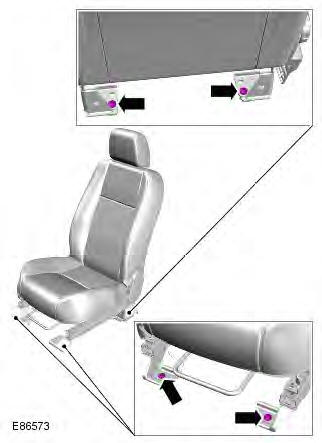
- Carefully remove the trim panels covering the seat frame fixing Torx screws.
- Check that the front seat frame fixing Torx screws are secure and that the seat frames show no signs of movement.
- Install the trim panels on completion.
Rear Seats
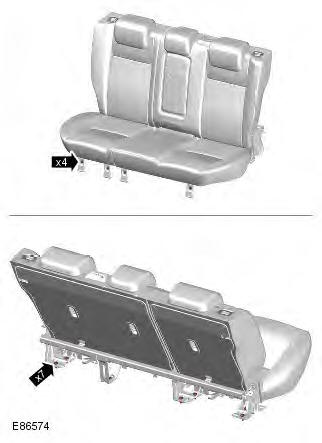
- Check that the seat frame fixings are secure and that the seat frames show no signs of movement.
Safety Belts
Front Seat Belt Mountings
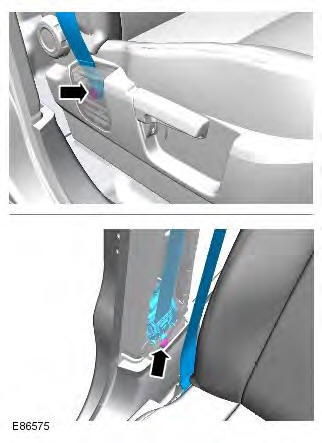
Rear Seat Belt Mountings
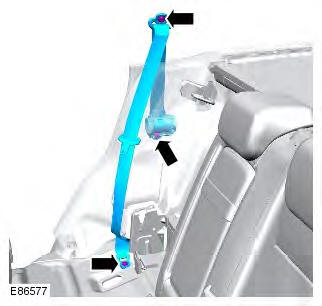
Reel Mounting - Center Rear Seat Belt
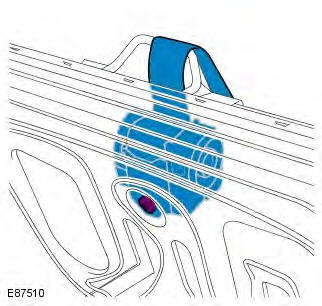
Buckle Mounting - Center Rear seat Belt
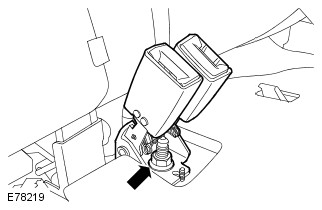
1. Fully extend each safety belt and check that it returns unassisted; repeat for all belts.
2. Check entire length of safety belt webbing for signs of fraying or damage: repeat for all belts.
3. Connect each safety belt to the correct buckle, check safety belt buckle and tongue are secure; check that buckle releases tongue correctly.
4. Check all safety belt and buckle mountings and fixings for security.
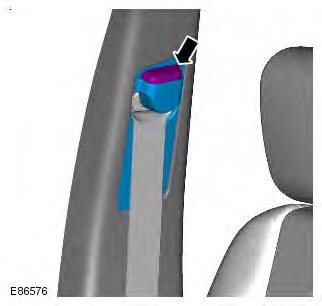
5. Check front safety belt height adjusters for correct operation.
Lamps, Horns and Warning Indicators
- Check side, head, fog, reversing and tail lamps for correct operation.
- Check operation of headlamp automatic levelling system - if installed.
- Check turn signals and hazard warning lamps for correct operation.
- Check brake (stop) lamps for correct operation.
- Check all exterior lamp lenses for clarity and condition; pay particular attention to headlamp and fog lamp lenses for stone chips or damage.
- Check horn for loud, clear sound.
- Switch on headlamps and check that side/headlamp reminder warning sounds when door is opened.
- Check operation of interior courtesy lamps.
- Check operation of all instrument pack warning and indicator lamps.
Washers and Wipers
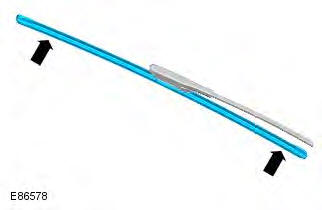
- Check all wiper blades for condition and signs of splits or damage.
- Check security of wiper arms.
- Operate front and rear screen washers, check that jets are clear and correctly aimed.
- Operate front and rear wipers at all speeds and check for smooth, smear free operation.
Parking brake
With the vehicle stationary, apply the parking brake and check for correct operation.
For additional information, refer to: Parking Brake (206-05 Parking Brake and Actuation, Description and Operation).
Pollen Filter
- Replace pollen filter.
For additional information, refer to: Pollen Filter (412-01 Climate Control, Removal and Installation).
Vehicle Exterior
Wheels and Tires
- Check that tires comply with manufacturer's specification.
For additional information, refer to: Specifications (204-04 Wheels and Tires, Specifications).
- Check/adjust tire pressures including spare.
For additional information, refer to: Specifications (204-04 Wheels and Tires, Specifications).
- Vehicle fitted with Uni-directional tires: Mark the wheel to stud relationship of each road wheel and note location of each road wheel to its respective hub.
- Loosen road wheel nuts. Raise vehicle to a wheel free condition.
For additional information, refer to: Lifting (100-02 Jacking and Lifting, Description and Operation).
- Remove the road wheels.
- Visually check tires for condition, lumps or bulges. Check tread depth across the width of the tire and around the circumference; ensure that remaining tread depth does not contravene local legislative requirements.
 NOTE: Do not
install wheels at this stage.
NOTE: Do not
install wheels at this stage.
Braking System
1. Inspect front brake pads for wear.
For additional information, refer to: Specifications (206-03 Front Disc Brake, Specifications).
2. Inspect rear brake pads for wear.
For additional information, refer to: Specifications (206-04 Rear Disc Brake, Specifications).
3. Check brake calipers for signs of fluid leaks.
Front brakes
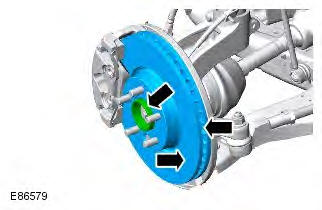
Rear brakes
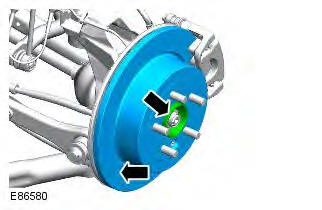
4. Check brake discs for condition.
5. Check all brake booster and brake system pipes and hoses for condition, chafing and leaks.
6. Clean road wheel hub spigots and apply grease, Land Rover Part Number RYL 105020 to the wheel mating surface of each spigot.
7. Replace brake fluid. For additional information, refer to: Brake System Pressure Bleeding (206-00 Brake System - General Information, General Procedures).
8. Vehicles fitted with Uni-directional tires:Install road wheels on their respective hubs ensuring that stud to wheel relationship is maintained.
9. Vehicles fitted with NON Uni-directional tires: Install wheels on the opposite side of the vehicle but ensure that they are on the same axle as they were originally installed.
10. Install road wheel nuts and tighten to 133 Nm (98 lb-ft).
Drain fuel sedimentor
Drain water from the fuel filter.
Fuel Filter
Replace the fuel filter.
For additional information, refer to: Fuel Filter (310-01A Fuel Tank and Lines - TD4 2.2L Diesel, Removal and Installation).
Door Locks and Hinges
1. Check operation of all door locks, bonnet lock and fuel filler flap.
2. Lubricate all door check straps, bonnet catch and fuel filler flap catch. Russian and Nordic markets only
Under bonnet
Cooling System
 CAUTIONS:
Anti-freeze concentration must be maintained at 50%.
CAUTIONS:
Anti-freeze concentration must be maintained at 50%.
1. Check specific gravity of coolant using a hydrometer.
 NOTE: A
suitable hydrometer is available from the Equipment Programme under Part Number
511 3302 001 00.
NOTE: A
suitable hydrometer is available from the Equipment Programme under Part Number
511 3302 001 00.
2. Top-up cooling system if necessary.
For additional information, refer to: Specifications (303-03A Engine Cooling - TD4 2.2L Diesel, Specifications).
Cooling system - Check/Top-up
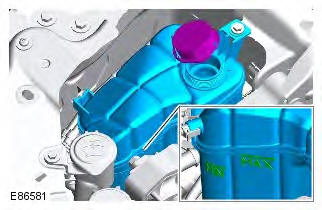
 WARNING:
Since injury such as scalding could be caused by escaping steam or coolant, do
not remove the filler
cap from the coolant expansion tank whilst the system is hot.
WARNING:
Since injury such as scalding could be caused by escaping steam or coolant, do
not remove the filler
cap from the coolant expansion tank whilst the system is hot.
 CAUTIONS:
CAUTIONS:
Engine coolant will damage the paint finished surfaces. If coolant is spilled, immediately remove the coolant and wash the area with water.
Always top-up with a 50% mixture of anti-freeze and water.
- Check the level of coolant in the expansion tank. With the engine cold, the coolant level must be to the UPPER LEVEL indicator mark above the COLD FILL RANGE text on the side of the expansion tank. Ignore any coolant which may be visible in the top section of the tank.
- If topping-up is required, remove expansion tank filler cap and top-up
coolant level to the UPPER LEVEL indicator
mark.
For additional information, refer to: Specifications (303-03A Engine Cooling - TD4 2.2L Diesel, Specifications).
- Install expansion tank filler cap, tighten cap until ratchet is heard to 'click'.
Coolant - Replace
Replace the coolant.
For additional information, refer to: Cooling System Draining, Filling and Bleeding (303-03A Engine Cooling - TD4 2.2L Diesel, General Procedures).
Air Filtering
1. Replace the air cleaner element.
For additional information, refer to: Air Cleaner Element (303-12A Intake Air Distribution and Filtering - TD4 2.2L Diesel, Removal and Installation).
Accessory Drive Belt
- Check the condition of the accessory drive belt.
- Remove all traces of mud and dirt from the drive belt and pulleys.
- Check the drive belt for signs of splitting and wear.
Replace the accessory drive belt. For additional information, refer to: Accessory Drive Belt (303-05A Accessory Drive - TD4 2.2L Diesel, Removal and Installation).
Camshaft Timing Belt, Tensioner and Pulley
Replacing the camshaft timing belt, tensioner and pulley.
For additional information, refer to: Timing Belt (303-01A Engine - TD4 2.2L Diesel, Removal and Installation).
Fluid levels
Brake Fluid Reservoir
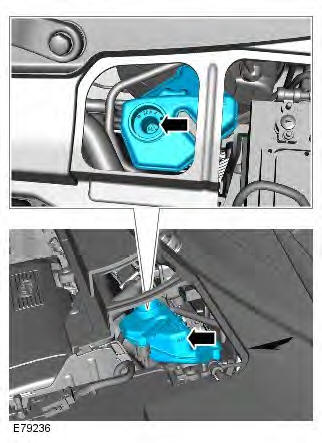
- Remove the brake fluid reservoir cover.
- Check the fluid level in the brake fluid reservoir, the level must be to the MAX mark on the reservoir; top-up if necessary.
- Clean the area around the reservoir filler cap, remove cap.
- If necessary, top-up using the recommended fluid to the MAX mark on the
reservoir.
For additional information, refer to: Specifications (206-00 Brake System - General Information, Specifications).
- Install the reservoir filler cap.
- Install the brake fluid reservoir cover.
Windshield Washer Reservoir
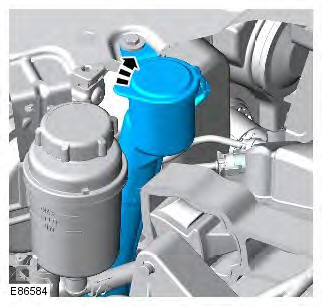
- Remove the windshield washer reservoir filler cap.
- Top-up the reservoir using a mixture of an approved windshield washer fluid and water until the level is to the bottom of the gauze filter in the reservoir filler neck.
- Install the reservoir filler cap.
Battery
- Check condition of battery.
- Check/top up battery electrolyte level.
Engine Oil and Filter
 CAUTIONS:
CAUTIONS:
Vehicles operating on high sulphur content fuel - above 0.7%, the oil and filter change period MUST NOT exceed 3 months or 3,750 miles (6,000 km).
Vehicles operating on moderate sulphur content fuel - 0.3 to 0.7%, the oil and filter change period MUST NOT exceed 6 months or 7,500 miles (12,000 km).
- Renew engine oil and filter.
For additional information, refer to: Engine Oil Draining and Filling (303-01A Engine - TD4 2.2L Diesel, General Procedures).
Under vehicle
Manual transmission oil
- Renew manual transmission oil.
For additional information, refer to: Transmission Draining and Filling (308-03 Manual Transmission/Transaxle, General Procedures).
Automatic transmission oil
- Renew automatic transmission oil.
For additional information, refer to: Transmission Fluid Drain and Refill (307-01 Automatic Transmission/Transaxle, General Procedures).
Suspension mounting rubbers
Check for free play in all suspension mounting rubbers.
Suspension, Driveshafts, Steering boots and gaiters
Check condition of all suspension, driveshafts, steering boots and gaiters.
Brake hoses
Replace all flexible brake hoses
Brake servo hose, Brake, Fuel, PAS and Clutch pipes and unions
Check visually brake servo hose, brake, fuel, PAS and clutch pipes, unions, and electrical harnesses for chafing, leaks and corrosion.
Fuel leaks
Check for fuel leaks.
Exhaust system
Check exhaust system for leaks, security and damage
Steering rod ball joints
Check steering rod ball joint fixings and condition of ball joints and dust covers.
Fault lamps
If fault lamp(s) are illuminated, interrogate that system using SDD and report findings.
Service interval
Reset the service interval announcement indicator.
For additional information, refer to: Service Indicator Reset (413-09, General Procedures).
Service record
Endorse service record.
Service actions or recalls
Check for any applicable outstanding service actions or recalls.
Report additional work
Report any unusual features of vehicle condition and additional work required.

